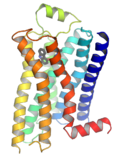G protein-coupled receptor
G protein-coupled receptors (GPCRs), also known as seven-(pass)-transmembrane domain receptors, 7TM receptors, heptahelical receptors, serpentine receptor, and G protein-linked receptors (GPLR), constitute a large protein family of receptors that detect molecules outside the cell and activate internal signal transduction pathways and, ultimately, cellular responses.
Structure[edit]
GPCRs are integral membrane proteins that possess seven transmembrane domains. The extracellular parts of the receptor can be glycosylated. These extracellular loops also contain two highly conserved cysteine residues which build disulfide bonds to stabilize the receptor structure. Some of the GPCRs also possess an extracellular N-terminus domain which binds the ligand, for example, the rhodopsin family of GPCRs.
Function[edit]
GPCRs are involved in a wide variety of physiological processes. Some examples of their physiological roles include:
- The visual sense: The photoreceptor cells in the retina possess the photoreceptor protein, which is a GPCR. The opsin in these proteins undergoes a conformational change when it absorbs a photon, leading to a series of events which ends in an electrical signal being sent to the brain.
- The gustatory sense (taste): GPCRs in taste cells mediate release of intracellular calcium, allowing the cell to release neurotransmitters into the synaptic cleft.
- The sense of smell: Receptors of the olfactory epithelium bind odorants, and, here again, use GPCRs to produce an electrical signal.
- Behavioral and mood regulation: Receptors in the mammalian brain bind several different neurotransmitters, including serotonin, dopamine, GABA, and glutamate.
- Regulation of immune system activity and inflammation: Chemokine receptors bind ligands that mediate intercellular communication between cells of the immune system. GPCRs are also involved in immune-modulation and directly involved in suppression of TLR-induced immune responses from T cells.
Classification[edit]
GPCRs are classified by the International Union of Basic and Clinical Pharmacology (IUPHAR) into several families, based on sequence homology:
- Class A (or 1) (Rhodopsin-like)
- Class B (or 2) (Secretin receptor family)
- Class C (or 3) (Metabotropic glutamate/pheromone)
- Class D (or 4) (Fungal mating pheromone receptors)
- Class E (or 5) (Cyclic AMP receptors)
- Class F (or 6) (Frizzled/Smoothened)
See also[edit]
- Adrenergic receptor
- Dopamine receptor
- Histamine receptor
- Serotonin receptor
- Metabotropic glutamate receptor
References[edit]
<references />
This GPCR-related article is a stub. You can help WikiMD by expanding it.
-
G protein-coupled receptor
-
G protein-coupled receptor
-
G protein-coupled receptor
-
G protein-coupled receptor
-
G protein-coupled receptor
-
G protein-coupled receptor
-
G protein-coupled receptor
-
G protein-coupled receptor
-
G protein-coupled receptor
-
G protein-coupled receptor
-
G protein-coupled receptor
-
G protein-coupled receptor
Ad. Transform your life with W8MD's Budget GLP-1 injections from $75


W8MD offers a medical weight loss program to lose weight in Philadelphia. Our physician-supervised medical weight loss provides:
- Weight loss injections in NYC (generic and brand names):
- Zepbound / Mounjaro, Wegovy / Ozempic, Saxenda
- Most insurances accepted or discounted self-pay rates. We will obtain insurance prior authorizations if needed.
- Generic GLP1 weight loss injections from $75 for the starting dose.
- Also offer prescription weight loss medications including Phentermine, Qsymia, Diethylpropion, Contrave etc.
NYC weight loss doctor appointmentsNYC weight loss doctor appointments
Start your NYC weight loss journey today at our NYC medical weight loss and Philadelphia medical weight loss clinics.
- Call 718-946-5500 to lose weight in NYC or for medical weight loss in Philadelphia 215-676-2334.
- Tags:NYC medical weight loss, Philadelphia lose weight Zepbound NYC, Budget GLP1 weight loss injections, Wegovy Philadelphia, Wegovy NYC, Philadelphia medical weight loss, Brookly weight loss and Wegovy NYC
|
WikiMD's Wellness Encyclopedia |
| Let Food Be Thy Medicine Medicine Thy Food - Hippocrates |
Medical Disclaimer: WikiMD is not a substitute for professional medical advice. The information on WikiMD is provided as an information resource only, may be incorrect, outdated or misleading, and is not to be used or relied on for any diagnostic or treatment purposes. Please consult your health care provider before making any healthcare decisions or for guidance about a specific medical condition. WikiMD expressly disclaims responsibility, and shall have no liability, for any damages, loss, injury, or liability whatsoever suffered as a result of your reliance on the information contained in this site. By visiting this site you agree to the foregoing terms and conditions, which may from time to time be changed or supplemented by WikiMD. If you do not agree to the foregoing terms and conditions, you should not enter or use this site. See full disclaimer.
Credits:Most images are courtesy of Wikimedia commons, and templates, categories Wikipedia, licensed under CC BY SA or similar.
Translate this page: - East Asian
中文,
日本,
한국어,
South Asian
हिन्दी,
தமிழ்,
తెలుగు,
Urdu,
ಕನ್ನಡ,
Southeast Asian
Indonesian,
Vietnamese,
Thai,
မြန်မာဘာသာ,
বাংলা
European
español,
Deutsch,
français,
Greek,
português do Brasil,
polski,
română,
русский,
Nederlands,
norsk,
svenska,
suomi,
Italian
Middle Eastern & African
عربى,
Turkish,
Persian,
Hebrew,
Afrikaans,
isiZulu,
Kiswahili,
Other
Bulgarian,
Hungarian,
Czech,
Swedish,
മലയാളം,
मराठी,
ਪੰਜਾਬੀ,
ગુજરાતી,
Portuguese,
Ukrainian










